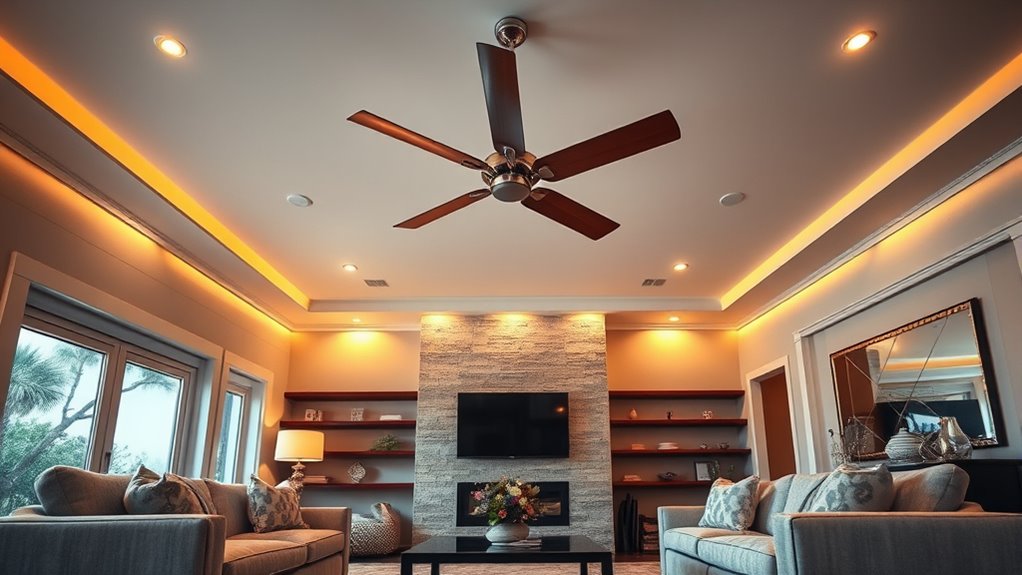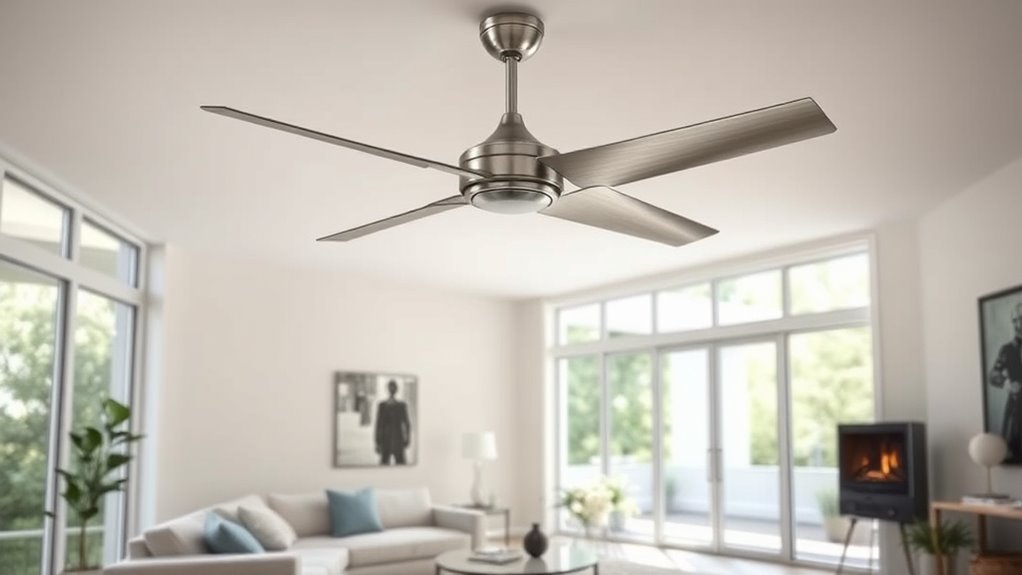To choose the right ceiling fan size for your space, consider your room’s dimensions and ceiling height for a balanced look and efficient airflow. In smaller rooms, go for fans with 36-42 inch blades, while larger areas benefit from 52 inches or more. For high ceilings, longer down rods help maintain proper blade height, ensuring harmony with your decor. Focusing on both function and style results in a seamless blend of comfort and aesthetic appeal—continue on for expert tips that inspire your perfect choice.
Key Takeaways
- Match fan blade span to room size: 36-42 inches for small rooms, 52 inches or more for large spaces.
- Consider ceiling height: use longer down rods or high-ceiling fans for vaulted or high ceilings.
- Balance aesthetics and functionality: select fan finishes and styles that complement your decor while providing adequate airflow.
- Ensure proper placement: position blades at the optimal distance from the floor for efficiency and visual harmony.
- Prioritize room proportions: choose a size that enhances room scale without overwhelming or underperforming.

Selecting the right ceiling fan size is vital for achieving both ideal airflow and a cohesive aesthetic in your space. The size of your fan directly influences the room’s atmosphere, comfort, and visual harmony. A fan that’s too small won’t circulate air effectively, leaving your room feeling stagnant, while an oversized fan can overpower the space, creating a cluttered or awkward look. To make the best choice, you need to consider both the room’s dimensions and its design style, guaranteeing that the fan complements your décor while fulfilling its functional role.
Choosing the right ceiling fan size balances airflow, style, and room proportions for a harmonious space.
For smaller rooms, such as bedrooms or cozy reading nooks, a fan with a blade span of 36 to 42 inches generally suffices. These fans provide enough airflow without dominating the space or disrupting the room’s proportion. When choosing, focus on sleek, minimalist designs that blend seamlessly with your furnishings, emphasizing clean lines and subtle finishes to maintain an intimate, inviting feel. In contrast, larger living rooms or open-concept areas benefit from fans with a blade span of 52 inches or more, which can move air efficiently across expansive areas. Opt for fans with a balanced, symmetrical design that anchors the room visually, avoiding overly ornate details that might distract from the overall décor.
Ceiling height plays a vital role in your decision. If your ceilings are standard height—around 8 feet—a fan with a down rod of about 4 inches will keep airflow ideal and maintain visual balance. Higher ceilings, such as those in vaulted or cathedral spaces, call for longer down rods or fans designed specifically for high ceilings. These ensure the blades are positioned at an ideal distance from the floor, maximizing airflow and preventing the fan from feeling disconnected from the room’s scale. Additionally, choosing a fan with the appropriate size helps create a harmonious room proportion, ensuring the fan complements rather than competes with your interior elements.
Material and finish also matter, especially when considering size. Larger fans often feature bold blades or striking finishes that serve as statement pieces, so choose those that resonate with your room’s color palette and interior style. Matte black, brushed nickel, or wood finishes can add warmth or modernity, depending on your aesthetic. Conversely, smaller fans tend to have more delicate, refined finishes that subtly enhance the space without overwhelming it.
Ultimately, selecting the right ceiling fan size involves balancing functionality with design sensibility. You want it to circulate air effectively, but also to look like a natural extension of your room’s style. By paying careful attention to dimensions, ceiling height, and finishes, you guarantee your fan becomes both a practical fixture and a thoughtfully curated element of your interior design.
Frequently Asked Questions
Can I Install a Larger Fan in a Small Room?
Yes, you can install a larger fan in a small room, but it might overwhelm the space and look out of proportion. A bigger fan can circulate air more effectively, but it could also create noise or feel intrusive. To maintain aesthetic harmony, choose a larger fan only if it complements your room’s design and verify the blade span isn’t too wide for the ceiling height, preserving both style and comfort.
How Does Ceiling Height Affect Fan Size Choice?
You should select a fan size based on ceiling height to guarantee ideal airflow and safety. For ceilings under 8 feet, choose a flush mount or low-profile fan to avoid clearance issues and maintain a sleek look. If your ceiling is higher, opt for a larger fan with an extended downrod, which helps distribute air evenly and complements the room’s proportions. Always prioritize both style and function.
Are Energy-Efficient Fans Available for Different Room Sizes?
Think of energy-efficient fans as the elegant chariots of modern comfort—designed to glide smoothly through your space while conserving fuel. Yes, they come in various sizes tailored to room dimensions, ensuring ideal airflow without excess energy use. Whether you need a sleek, compact model for a cozy nook or a more substantial fan for a spacious living area, today’s options blend sophistication with sustainability, making every breeze both stylish and eco-friendly.
What Materials Are Best for Humid Environments?
For humid environments, opt for materials like stainless steel, aluminum, or treated teak, which resist moisture and corrosion. You’ll want fans with moisture-resistant finishes and rust-proof blades that maintain their beauty over time. Avoid materials like untreated wood or low-quality plastics that can warp or degrade. Select designs with sleek, modern lines and subtle textures, ensuring your fan complements your space while enduring the humidity with style and durability.
How Often Should I Replace or Upgrade My Ceiling Fan?
Think of your ceiling fan as a trusted dance partner—occasionally, it’s time for a new routine. You should consider replacing or upgrading your fan every 10 to 15 years, especially if it starts to wobble, sounds offbeat, or no longer cools efficiently. Regular maintenance, like cleaning and checking for wear, extends its life, but a new fan keeps your space stylish and breezy, like a gust of fresh air.
Conclusion
Now that you know how to choose the perfect ceiling fan size for each space, imagine the subtle elegance it will bring to your room. Every detail, from blade length to design, plays a role in transforming your environment. But the real secret lies in selecting the one that perfectly balances style and function—ready to elevate your space in ways you haven’t yet imagined. Are you prepared to make that stylish, impactful choice?








